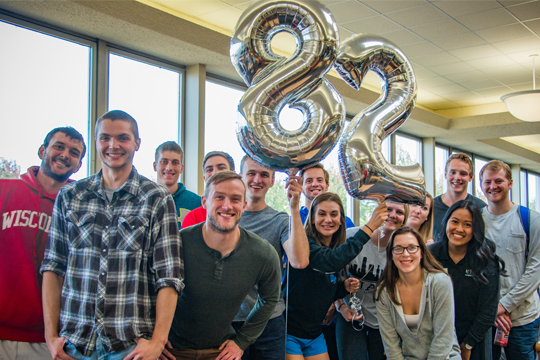 Concordia students take a break from studying to commemorate their campus’s retention achievement.
Concordia students take a break from studying to commemorate their campus’s retention achievement. Concordia University Wisconsin set an all-time retention record this year, with 82 percent of the fall 2016 incoming freshmen class having returned to pursue undergraduate degrees at the Mequon-based campus this semester, according to data released Oct. 1.
That percentage beats out the average rate of the typical and comparable national private university by 3 percent. It’s also seven points above Concordia’s previous 10-year average retention number.
While enrollment numbers often dominate news reports, Concordia’s Research Analyst and Specialist Paul Wangerin says a school’s retention rate is equally—if not more—important to consider.
“Research shows that the best gauge schools have of student satisfaction is retention rates,” Wangerin says. “If they are satisfied, they remain. Retention is a good indicator of how well things worked for a school’s new students.”
Wangerin says the shift in retention can be attributed to a number of factors. The fact that the class was smaller may have played a partial role. Fewer students can mean optimal access to resources that help foster student satisfaction, such as parking, housing, or food and student services.
The 2016 cohort also performed better on the whole academically than previous years’ cohorts. Students who are successful in academics at an institution are much more likely to remain there, says Wangerin.
“It’s a reflection of the institution as a whole when we achieve a success like this—from recruiting good students to helping them succeed once they are here,” Wangerin says.
Academic support services like Concordia’s Striving Towards Academic Recovery (STAR) and PROSPER programs—for students on academic probation and for those at-risk upon entry into the university—are important pieces of the retention model as well.
Last year—the second year for the PROSPER program—saw 23 of the 39 eligible students engage with the program. Ninety percent of PROSPER students finished their first year in good academic standing, and 16 of those 23 have returned for the fall 2017 semester.
Additionally, 85 percent of students on academic probation in 2016 engaged in the inaugural semester of the Striving Towards Academic Recovery (STAR) program. STAR students earned more than twice as many credits in the spring 2017 semester and twice as many grades of C or higher as students who did not engage in the program. Students who elected to have a STAR coach were also twice as likely to return to good academic standing.
“We’ve had a tremendously successful start with both of these academic support programs, thanks largely to the faculty and staff who volunteered their time to help our students succeed,” says Assistant VP of Academics Elizabeth Polzin. “At Concordia, we place a priority on providing access and opportunity for all learners, and a key piece of that is supporting those who need it once they’re admitted.”
Both academic coaching programs were formed in direct response to census data, says Wangerin. Each year after the October report date, key university personnel sit down to review the numbers and develop strategies in response to them.
“We’re like a doctor giving a diagnosis and looking for symptoms to address,” Wangerin says. “If the numbers show that something is working well, we recognize this and continue doing it. More importantly we look at where we are struggling and make plans to intervene. In the instance of our record retention rate, I think a lot of people did a whole lot of good for us to be in this place.”
— This story is written by Kali Thiel. Kali was Director of University Communications until April, 2025.
If this story has inspired you, why not explore how you can help further Concordia's mission through giving.